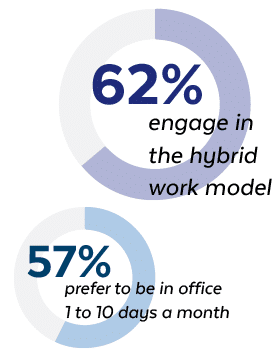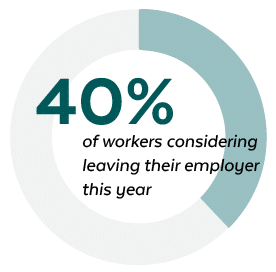One of the more creative adaptations to the pandemic has been the concept of the hybrid workplace. Back in 2020, during the height of COVID-19, employers found themselves at a breaking point. They needed to be resourceful to maintain their business and productivity goals and still keep their workers safe. This set the scene for the hybrid workplace.
 When COVID-19 waned and our economy began to recover, there was much optimism that workers would be able to return en masse to their place of work. But, then, the Delta variant hit—and after that, Omicron. And now it appears that work may never be the same again.
When COVID-19 waned and our economy began to recover, there was much optimism that workers would be able to return en masse to their place of work. But, then, the Delta variant hit—and after that, Omicron. And now it appears that work may never be the same again.
A September 2021 survey conducted by Dimensional Research backs up this claim. Here are some key findings:
- 62 percent of those surveyed were already engaged in the hybrid work model
- 57 percent stated that when offices are fully open, they would prefer to be in the office only one to ten days a month.
The survey’s conclusion states:
This research finds that the hybrid work model is happening now and is widespread. A majority of those surveyed already split time working from home and in the office. Employees want the benefits of working remotely and are so committed to the hybrid work model they will consider finding new employment to protect it.
What is a hybrid work model?
A hybrid office (also called “office + anywhere”) is a working model in which a company’s managers and employees work together in a physical office and remotely from home or both. There are a variety of ways to do this. For instance, some businesses may require employees to work from the office only one to three days a week, with the remaining days worked remotely from home. Or the company may decide what works best is some workers who work strictly from the office, while the rest work strictly from home. While still others may use a combination of the two. Whatever the arrangement, a hybrid work model generally permits employees to fit work into their lives, rather than dictating work into fixed hours in the office. For many employers and employees, this is an opportunity to balance productive work with less stress and less commuting time.
What are the benefits of a hybrid work model?
As you make decisions regarding your return-to-office policies, consider these four hybrid work model advantages:
1) Increased Productivity
A hybrid work model offers flexibility and empowers employees to choose a working schedule that plays to their individual strengths. It allows teams to work out a satisfactory work balance between deep-focus tasks and collaborative ones. 
Gartner states that an organization needs four different work modes to have a successful hybrid environment:
- Working together, together: when teams are co-located, contributing to meetings in a shared space.
- Working together, apart: when teams are distributed, but participating in virtual meetings
- Working alone, together: when teams are in shared spaces, but not working at the same time.
- Working alone, apart: when teams are distributed, and individuals are conducting deep-focus work.
2) Improved Employee Satisfaction and Company Culture
Here’s a guarantee: If workers are given the independence to determine how, when, and where they work, employee satisfaction will skyrocket. An important component here is trust. A company culture that embraces trust and assumes people can get their work done without a manager standing over them fosters loyalty, mutual appreciation, and respect. If you do not understand what an employee is working on, simply ask them something like, “Can you help me understand what you are doing and why?”
One of the best outcomes of a hybrid work model is that employees can choose to work outside of traditional work hours and in environments that are less stressful and more conducive to creative thinking.
3) Improved Collaboration and Relationships
To make a hybrid work model successful, employers must change their role to that of a facilitator. Company leaders must focus on how human relationships work. A company that values collaboration and openness will create a culture that has strong relationships and robust, honest communication.
4) Improved Mental Health
According to a global survey by Microsoft, one in five respondents feels their employer has little or no concern for their work-life balance. A proper hybrid work model shows sensitivity to this type of employee stress. When a worker is able to coordinate work and life flexibly, stress is reduced, which in turn helps to prevent burnout. When people can meet both work and life responsibilities, they are less stressed and have a larger sense of wellbeing.
Why should I consider a hybrid work model for my business?
The writing is on the wall, hybrid workplaces are here to stay. Microsoft states:
With over 40 percent of the global workforce considering leaving their employer this year, a thoughtful approach to hybrid work will be critical for attracting and retaining diverse talent.
Microsoft has identified seven tenets that will shape the future of a hybrid work world:
- Flexible work is here to stay.
- Leaders are out of touch with employees and need a wake-up call.
- High productivity is masking an exhausted workforce.
-
- Gen Z is at risk and will need to be re-energized.
- Shrinking networks are endangering innovation.
- Authenticity will spur productivity and wellbeing.
- Talent is everywhere in a hybrid world.
We will end this article with a quote from Satya Nadella, CEO of Microsoft:
Over the past year, no area has undergone more rapid transformation than the way we work. Employee expectations are changing, and we will need to define productivity much more broadly—inclusive of collaboration, learning, and wellbeing to drive career advancement for every worker, including frontline and knowledge workers, as well as for new graduates and those who are in the workforce today. All this needs to be done with flexibility in when, where, and how people work.
Versa Technology delivers last-mile networking solutions to a global community of IT professionals in North America, South America, China, Europe, Australia, South East Asia, Africa, and many more regions worldwide. Our equipment is ideal for developed and developing countries alike. It has been Versa Technology’s unwavering mission to sell market industry-leading products that are versatile, user-friendly, and cost-effective since our inception in 1994. We invite you to visit our product page.

